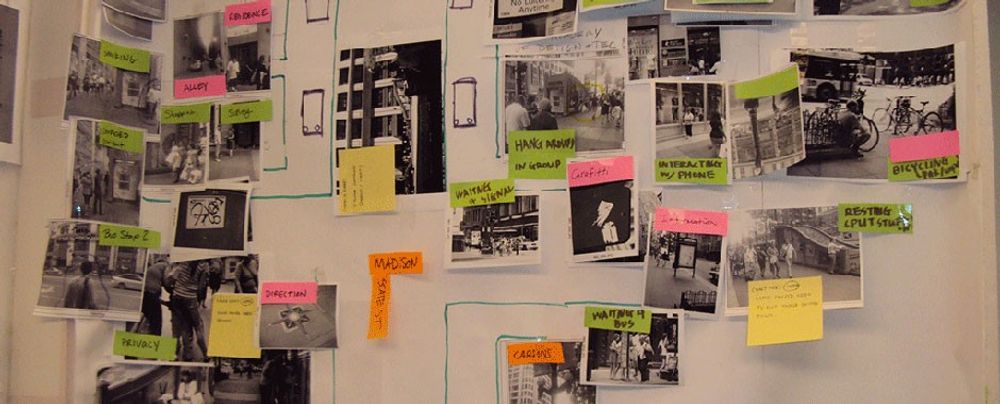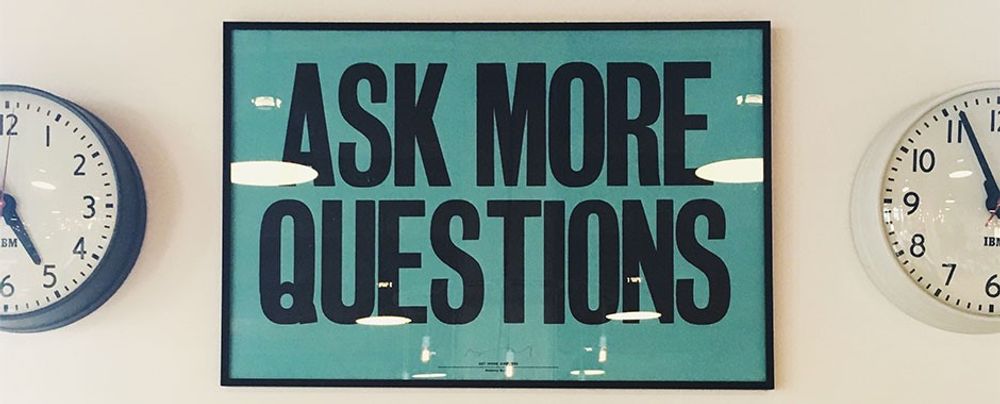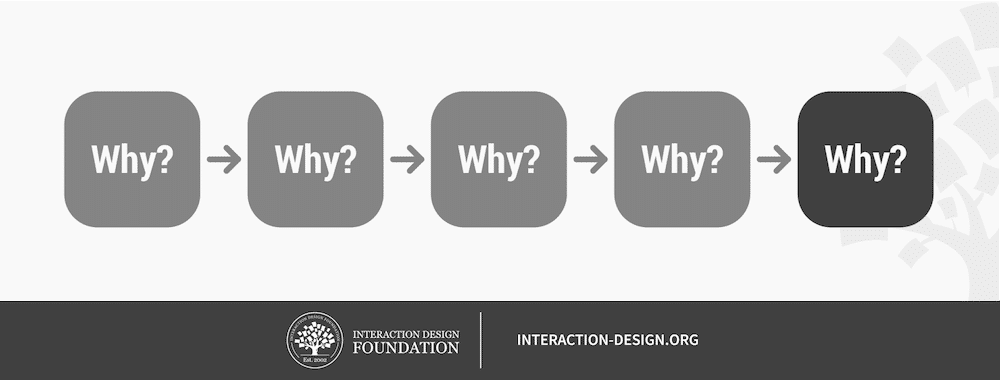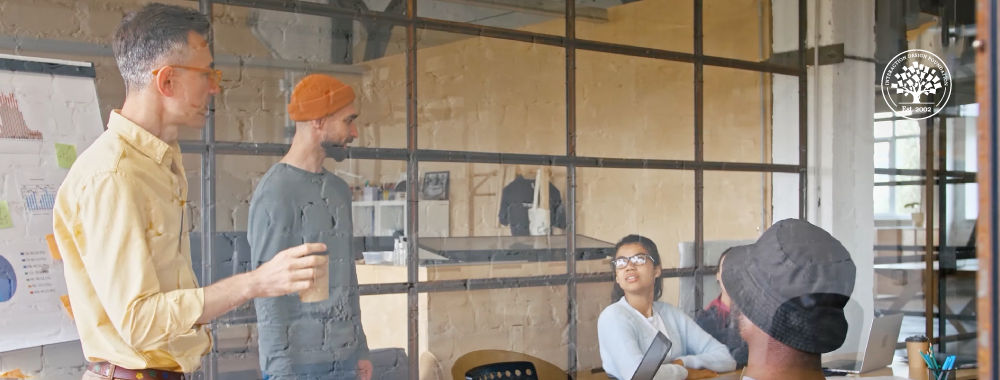Laddering Questions Drilling Down Deep and Moving Sideways in UX Research

- 724 shares
- 9 years ago
The 5 Whys method is an iterative interrogative technique pioneered at Toyota Motor Corporation in the 1930s to explore the cause-and-effect relationships underlying a specific problem. By working back from one effect to another up to five times, designers can expose root causes and explore effective solutions.
“Be ahead of the times through endless creativity, inquisitiveness and pursuit of improvement.”
— Sakichi Toyoda, Japanese industrialist and inventor who formulated the 5 Whys method
See why 5 Whys is such a valuable tool.
To ask why something happened is a natural, effective way to uncover a problem, be it a high bounce rate on a website, a marketplace failure or anything else you may want to know about users, etc. However, cause-and-effect chains can be long and complex. Whether they occur in the natural or human world, end-result events rarely happen in isolation with only one cause to trigger them. The effects of one action or condition can be so far-reaching that it’s easy to jump to conclusions when you look at the end result. The greater the number of removes—or steps in a cause-and-effect chain—the more effort and insight it will take to work your way back to what actually started the whole sequence of events that ultimately resulted in the problem at hand. If you overlook any factors involved, you might end up making assumptions—and it’s essential to discard assumptions in user experience (UX) design.
The 5 Whys method was developed to work back to a root cause of a mechanical problem by a total of five removes. Toyota’s famous example illustrates the simple nature but immense power of the technique:
Why did the robot stop? The circuit overloaded, making a fuse blow.
Why? There was insufficient lubrication on the bearings, so they locked up.
Why? The oil pump on the robot wasn’t circulating enough oil.
Why? The pump intake was clogged with metal shavings.
Why? There was no filter on the pump.
In UX design—for example service design—system failures can be far more intricate than this. Users are humans who act in complex contexts, and their behaviors (and reasons for these) can be difficult to decipher, especially with so many channels and parts of their user journeys for you to examine. Most of what we first see when we look at an apparent problem (or, rather, its end result) is just on the surface. Symptoms can be misleading. On that note—and even more importantly for modern designers—the 5 Whys is an essential tool to dig down to root causes on a bigger scale. As cognitive science and user experience expert Don Norman advises in his 21st century design, human-centered design and humanity-centered design approaches, designers who want to effect real change in solving complex global-level problems need to get beneath the symptoms and apparent causes to discover and address what’s really going on. If you don’t solve the right problem—and work with the root cause—the symptoms will just come back.
You can use 5 Whys anytime in your design process, but it’s particularly helpful early on when you need to understand the problem facing your users, customers and/or stakeholders. As such, it’s a valuable aid in design thinking. When you conduct user research, the answers you can get by asking “why” repeatedly can arm your design team with many insights from users—insights which you can leverage to identify the real or underlying problem, and then iteratively gear your ideation efforts more accurately around it. You can use 5 Whys to:
Determine what’s important from the user’s/customer’s/stakeholder’s viewpoint.
Explore why users/customers/stakeholders think, feel and do what they do.
Analyze the information.
© Daniel Skrok and Interaction Design Foundation, CC BY-SA 3.0
Five Whys is especially helpful to use in the empathize stage of design thinking, when you’re gathering the information you need so you can proceed to define the problem to address. It’s exactly as it sounds: you:
Base the first question on the apparent end result.
Form the second question on the answer to this.
Form the third question on the answer to the second question.
Form the fourth question on the answer to the third.
Form the fifth question on the answer to the fourth.
For example: “Not as many customers are subscribing to the website’s newsletter after the design changed.”
Why? Most of them click the subscription-related button within two seconds after it appears.
Why? Because they’re used to seeing subscription-prompting pop-ups.
Why? Because the internet is full of these.
Why? Because organizations have grown used to deploying these with an automatic opt-in dark pattern for users to find it harder not to subscribe.
Why? Because automatic opt-out buttons or allowing users to freely think about newsletter subscriptions (i.e., without guiding them with a design pattern) mean fewer subscriptions.
Here, it appears the designer failed to use the automatic opt-in design pattern.
Tips:
You can frame your “why” questions with different wording (e.g., “What do you think made that happen?”).
Keep asking until you get to the root cause of why your users feel or behave a certain way. For example, if they say, “Because I felt like doing that,” try to prompt them to evaluate their statement (without annoying them).
You can ask fewer (or more) questions, whatever works.
Ask “Why?” even if you think you already know the answer: you may be surprised what insights you can evoke.

© Olya Kobruseva, CC0
Ready to shape the future, not just watch it happen? Join the Father of UX Design, Don Norman, in his two courses, Design for the 21st Century and Design for a Better World, and turn your care for people and the planet into design skills that elevate your impact, your confidence, and your career.
Read the inspiring book on how you can implement your design skills and knowledge to help solve complex global problems such as climate change, hunger and inequity. Norman, Donald A. Design for a Better World: Meaningful, Sustainable, Humanity Centered. Cambridge, MA, MA: The MIT Press, 2023.
You can use 5 Whys anytime in your design process. It’s particularly helpful early on when you need to understand the problem facing your users, customers and/or stakeholders. As such, it’s a valuable aid in the first phase of the design thinking process. Take our design thinking course and learn how to benefit from the 5 Whys method.
Read this UX Planet piece for in-depth insights on 5 Whys.
Designers use the 5 Whys to uncover the root cause behind a problem, not just its symptoms. By asking “Why?” five times in a row, they can dig deeper with each answer. This method helps move past surface-level thinking and reveals the real issue users face, often invisible from the first symptom or effect.
For example, a user might abandon a signup form. Why? It takes too long. Why? There are too many fields. Why? The team wanted full profiles. Why? They wanted better personalization. Why? Users complained about irrelevant content. Now the focus shifts from form length to smarter personalization.
This technique keeps teams focused on solving the right problem, not just the visible one. It’s especially useful in UX design, product design, service design, and systems thinking. Everything is a system—or a part of one—and when you have an effect or a symptom on show, it often does take four or five removes to get to the real root cause.
Watch as UX Pioneer and the Godfather of UX Design, Don Norman explains the 5 Whys approach:
Take our course Design for the 21st Century with Don Norman.
The 5 Whys technique follows a structured path toward one goal: uncovering the root cause of a problem. Unlike general follow-up questions, which can branch in many directions, the 5 Whys drill straight down into a single issue by repeatedly asking “Why?” about the previous answer.
This linear method keeps your focus tight and keeps you from getting sidetracked. While follow-up questions might explore multiple angles, the 5 Whys aim to peel away layers of assumptions and get to the heart of the problem. It’s a disciplined tool, not a casual conversation thread.
Designers often use it to avoid jumping to solutions too early. Some effects or symptoms might suggest incorrect “causes”—wrong because either the designer is assuming things and misdiagnoses the cause or they stop at a cause that isn’t the root cause but is instead another symptom. By drilling down into the matter and identifying the real cause, teams can design fixes that address the real need—not just treat symptoms.
Watch as UX Pioneer and the Godfather of UX Design, Don Norman explains the 5 Whys approach:
Take our course Design for the 21st Century with Don Norman.
In the Define phase—the second phase of the design thinking process—use the 5 Whys to pinpoint the root cause of user problems before crafting a problem statement. Begin with a clear observation or user complaint—like “Users abandon the checkout page.” Ask “Why?” five times, and each time build on the previous answer to dig deeper.
This method helps you move from symptoms to causes. Instead of leaving the matter at “Users drop off at checkout,” you might drill down beneath that to discover “Users don’t trust the payment security.” That insight makes your problem statement more focused, actionable, and user-centered. Five is a good number of times to ask because everything is part of a system and the chances are slim that a single remove or cause is behind the symptom you’re trying to address. What’s the cause of that? And then, what’s the cause of that? Keep going:
Problem → Why? → Cause
Problem → Cause → Why? → Cause
Problem → Cause → Cause → Why? → Cause
Problem → Cause → Cause → Cause → Why? → Cause
Problem → Cause → Cause → Cause → Cause → Why? → Root Cause
The 5 Whys also align your team around the real issue and prevent wasted effort solving the wrong problem. Use it in workshops or interviews, and document each step for clarity.
Watch as UX Pioneer and the Godfather of UX Design, Don Norman explains the 5 Whys approach:
Take our course Design for the 21st Century with Don Norman.
If your 5 Whys answers feel vague or shallow, return to the source. Talk to users directly or, better yet, observe them using the product or service. Real stories and behaviors give depth to your “Why” chain and help avoid guesswork that might otherwise render your research futile.
Get more details by rephrasing the “Why” questions if you need to. Instead of “Why did they stop?” ask “What made them stop right there?” Instead of general answers like “It’s confusing,” go for: “What part was confusing, and why?”. Be specific.
You can also bring in teammates to challenge assumptions. Group discussions often expose blind spots and force clearer thinking. If the path dries up, try starting from a different symptom or user action—it might lead you to a deeper insight. It’s like digging: the right place will have “soft soil” you can get through; “rockier” or “harder ground” may demand that you search for something else (i.e., a rephrased question).
Watch as UX Pioneer and the Godfather of UX Design, Don Norman explains the 5 Whys approach:
Take our course Design for the 21st Century with Don Norman.
One big mistake is stopping too early—often after just one or two “whys.” That leaves you with surface-level causes and symptoms and, therefore, shallow solutions if you try to address just those. Another common error is jumping to conclusions or inserting assumptions instead of facts. Stick to what users say or do—look at the evidence.
Some teams also treat the 5 Whys like a checklist. However, it’s not about hitting a number—it’s about uncovering the root cause. Go deeper only if each answer builds meaningfully on the last; you’ll know when to stop when you hit “bedrock” and can’t dig beneath that “why.”
Also, avoid asking “why” in a way that sounds accusatory. That can put users or teammates on the defensive. Rephrase a finger-pointing question with one that has authentic curiosity: “What led to that?” or “Can you explain why that happened?”
Last, but not least, don’t do it alone. Use team input to challenge biases and validate each step.
Watch as UX Pioneer and the Godfather of UX Design, Don Norman explains the 5 Whys approach:
Take our course Design for the 21st Century with Don Norman.
To stop your team from jumping to conclusions, slow the process down and anchor decisions in real user data. Let the evidence light the way. Start with a shared understanding: agree to explore the problem fully before considering solutions. Use tools like the 5 Whys to guide the team through deeper thinking and uncover root causes.
Facilitate sessions where everyone hears the same evidence, like user quotes, journey maps, or usability findings, before brainstorming. Encourage curiosity by asking open-ended questions like “What else could be causing this?” or “What don’t we know yet?”
Create space for reflection as well. Don’t rush from identifying a problem straight into ideation. Give your team time to sit with the findings.
This mindset shift helps teams stay focused on course to solving the right problem, not just the most obvious one.
Watch as UX Pioneer and the Godfather of UX Design, Don Norman explains the 5 Whys approach:
Take our course Design for the 21st Century with Don Norman.
Yes, you indeed can go beyond five whys. The number five is just a guideline, not a rule. The goal is to uncover the root cause. Sometimes that takes three “whys,” but there may be more: six, seven, or even more.
Keep digging if the fifth “why” still leaves you with a surface-level answer or assumption. However, don’t just ask more for the sake of it—each step should bring you closer to a deeper understanding of the problem. When the answers start repeating or lose relevance, well done—you’ve likely reached the root.
Remember, flexibility matters more than the count. The purpose of the exercise is insight, not hitting a number.
Watch as UX Pioneer and the Godfather of UX Design, Don Norman explains the 5 Whys approach:
Take our course Design for the 21st Century with Don Norman.
Yes, combining the 5 Whys with tools like journey maps or affinity diagrams makes your design process more robust. Use a journey map to spot moments where users struggle. Then, apply the 5 Whys to dig into why those pain points happen. This pairing reveals not just what’s going wrong and where (or when) in the user journey but also why it’s happening.
You can also use 5 Whys alongside affinity diagrams to group insights and cluster related root causes. Start by mapping out user feedback, and then dig into each theme using the 5 Whys to uncover deeper patterns.
When you use these tools together, they can help you power your way from scattered data to clear, focused problem statements that will help drive design decisions.
Watch as UX Pioneer and the Godfather of UX Design, Don Norman explains the 5 Whys approach:
Take our course Design for the 21st Century with Don Norman.
If your team doesn’t agree on the root cause, treat it as a sign to dig deeper, not a roadblock. Revisit the user data together. Walk through journey maps, user quotes, or session recordings to ground the discussion in facts instead of opinions.
Use the 5 Whys method as a team, writing out different possible cause chains. Compare them side by side to see where they diverge. Often, disagreement reveals multiple valid root causes, each worth exploring.
You can prototype simple tests for the competing causes, too. Collect feedback and let real user behavior settle the debate. Stay open, stay curious, and view the disagreement as fuel for better insights to gel together with, not something divisive or obstructive.
Watch as UX Pioneer and the Godfather of UX Design, Don Norman explains the 5 Whys approach:
Take our course Design for the 21st Century with Don Norman.
Moule, J. (2012). Killer UX design: Create User Experiences to Wow Your Visitors. SitePoint.
Killer UX Design by Jodie Moule offers a comprehensive, accessible approach to user-centered design, integrating practical tools like the “5 Whys” method to uncover the root causes of user frustrations. By encouraging designers to dig deeper into user behavior and motivations, Moule shows how techniques like the 5 Whys can guide teams to more thoughtful, lasting solutions. Her background in psychology enriches the book, compellingly connecting theory with practice. With a focus on iterative prototyping and real-world application, this book is a key resource for UX professionals aiming to design more intuitive, effective digital experiences grounded in user insight.
Remember, the more you learn about design, the more you make yourself valuable.
Improve your UX / UI Design skills and grow your career! Join IxDF now!
You earned your gift with a perfect score! Let us send it to you.
We've emailed your gift to name@email.com.
Improve your UX / UI Design skills and grow your career! Join IxDF now!
Here's the entire UX literature on 5 Whys by the Interaction Design Foundation, collated in one place:
Take a deep dive into 5 Whys with our course Design for the 21st Century with Don Norman .
Master complex skills effortlessly with proven best practices and toolkits directly from the world's top design experts. Meet your expert for this course:
Don Norman: Father of User Experience (UX) Design, author of the legendary book “The Design of Everyday Things,” co-founder of the Nielsen Norman Group, and former VP of the Advanced Technology Group of Apple.





We believe in Open Access and the democratization of knowledge. Unfortunately, world-class educational materials such as this page are normally hidden behind paywalls or in expensive textbooks.
If you want this to change, , link to us, or join us to help us democratize design knowledge!
